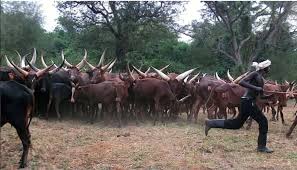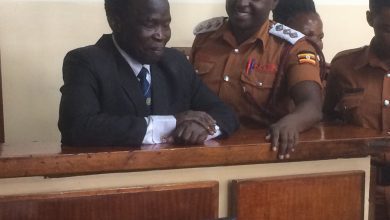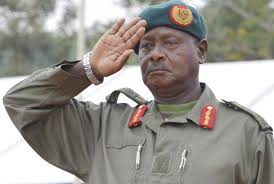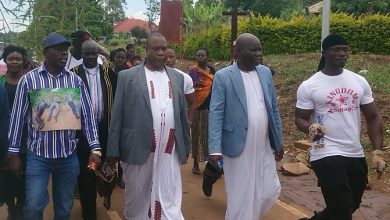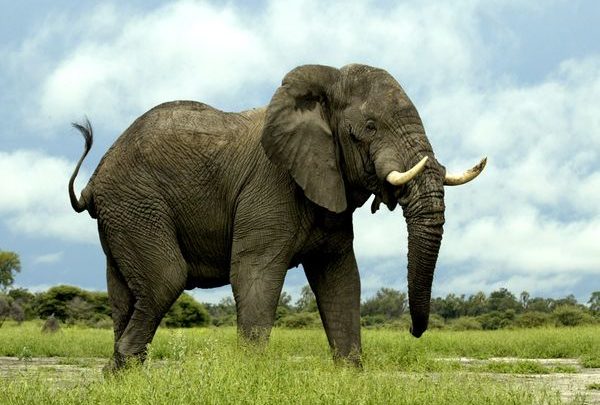
Global Politics
UGAMDA:LUO ROOT FROM MERO-KUSH 3000 BC TO 800 YEAR
The current LUO Stocks in Eastern, Central, Western and North Africa can be trace back to Meroe Kingdom, Middle East, Egyptian Civilizations
- By the way those V VBy ENG. Ochen Odoge
The Luo people emerged from the Semitic-speaking, Nilo-Saharan-speaking, Cushitic-speaking people. The Luo were originally a light-skinned community with the culture of Egypt (Tekidi), Kush and Meroe. They migrated to Kar Thum (Khartoum) to Wau in the Bar-el Ghazal region in South Sudan. It was here that they met a dark-skinned people who referred to them as Jur Chol (the aliens passing through the blacks).
- USA-CALIFORNIA: Between 990-1125, the Luos were in Sudan and then a series of calamities, including a serious outbreak of anthrax (‘opere’) and population explosion whipped out the entire livestock that were owned by the tribe of the Anu which was darker, and preferred both livestock and crop production. Following this incident, the community resorted to fishing along the Aora Nalo (the River Nile) for survival and this is how the Luo earned the name Jo-Oluo-Aora (people who follow the river) which, in the course of time came to be shortened to Luwo or Luo. South Sudan is hence the first placw that the Jo-Luo were first referred as such, the subsequent birthplace of the Luo nation. This explains why most tales of the origin of the Luo nation start from South Sudan at Dog nam (the Acholi equivalent of dhowath/ dho nam which is the Dholuo for the mouth of the lake – that is, a lake shore). Whereas there is no agreement on which lake it is, most historians identify it as Lake No or River Palugo, or what the Arabs called the ; Sea of Gazelle (Bar-el Ghazal). The three are the same thing.
According to oral tradition, the Luo lived in Eastern Bar-el-Ghazal until the year 1300 when they dispersed because of quarrel among the three brothers: Nyikang’o, Dimo and Gilo. Feuds within the homestead triggered by a power struggle led to a split and subsequently, separate history of the three groups. It was also during this period that the Luo started separating as a nation, into different sub-groups and going different directions, while also intermarrying with the various groups they met and assimilating their culture, or being assimilated into their cultures.
The Luo-speaking peoples include the following sub-groups:
1. Shilluk/ Ochollo – South Sudan / Ethiopia
2. Anuang’/ Anywaa – Ethiopia / South Sudan
3. Maban – South Sudan / Chad
4. Thuri / Shatt – South Sudan
5. Blanda Bor – South Sudan
6. Funj – South Sudan
7. Pari – South Sudan
8. Bari – South Sudan
9. Jumjum – South Sudan
10. Joluo / Jur Chol – South Sudan
11. Acholi – Uganda / South Sudan
12. Kumam – Uganda
13. Chope – Uganda
14. Tooro – Uganda
15. Lang’i – Uganda
16. Jonam – Uganda
17. Jo-Padhola – Uganda
18. Alur – Uganda / DRC / Cameroon
19. Suba Luo – Kenya
18. Joluo – Kenya / Tanzania
The Luo-speakers alongside the Dinka (Jieng’) and the Nuer (Naath) form part of the Jii-speakers.
Oral traditions reveal that the Southern Luo (the Luo of Kenya and Tanzania) descended from early fishing, agricultural and herding communities from western Kenya’s early pre-colonial history and dialects of their language have historic roots across the inter-lacustrine region. Besides their language has incorporated Bantu words making it different from the Ugandan Luo dialects, Dholuo is the mother tongue of the Luo community. There is only one major Luo dialect in Kenya, with minor variations of Luo language especially between the Alego / Ugenya / Gem locality, known as Trans Yala dialect by socio-linguist, and the standard Dholuo dialect which is largely spoken by the rest of the Luo people in Kenya and the neighboring Tanzania.
The Nilotic and Bantu populations now form one strong Luo community ethnic group. And despite of diverse ancestry of the Luo people, they have always remained united as one entity.
The Luo ethnic group in Kenya has maintained its culture, language and sustained the political unity and prevented further separation, thus, becoming a politico-cultural bloc in Kenya.
The early intrusion of the Luo in Nyanza basin was not, strictly-speaking, a conquest. Rat
her, it was a slow and peaceful penetration, and for a short while they lived with the original inhabitants. But when their numbers increased, friction developed between the newcomers and the aboriginals, forcing the former to use military and spiritual powers to take control of the land. Many of the indigenous people were forcefully expelled or assimilated and the Luo-speakers became the owners of a very large proportion of the land they settled.
After their last migrations, the Luo people settled on the North Eastern shores of Lake Victoria, that is Nyanza and North Mara Regions. The Luo tribe can be broken down into seven major sections based on origins. These sections are as follows:
1. Ramogi Luos (or commonly Luo proper)
2. Kawango Luos (Luo-Abasuba)
3. Kiseru Luos
4. Girango Luos
5. Sirati Luos
6. Imbo Luos
7. Other Luos
1. RAMOGI LUOS
The Luo proper are a Nilotic group of people who migrated from Bahr El -Ghazel region in South Sudan and settled in Kenya and Tanzania. According to Luo oral traditions, a warrior elder named Ramogi Ajwang’ led the Luo ethnic group into present day Kenya, about 500 years ago. The Luo people migrated into Nyanza in four major waves and they first settled at what is now called Got Ramogi (Ramogi Hills) in Yimbo. They later crossed in present day South Nyanza and eventually into North Mara Region, Tanzania. The four waves include the Jo-Kajok, Jo-Kowiny Jo-Komolo and Jo-Kawango (Luo-Abasuba), with the first wave arriving sometime around AD1490.
(i) The JOKA – JOK
The Joka – Jok sub-group was the first and largest Luo wave of migration. The group is claimed to have come from Acholiland, and ultimately from Napata or Tekidi (The foot of a great stone) in Upper Egypt. They were the earliest to arrive in Kenya between AD1490 and 1550 and their history is the history of the Southern Luo migration into Kenya.
(I) Pajok Clan cluster:
– Alego (Seje, Kadenge, and Kamiyawa Among the Sakwa-Kamasoga, Kamadhi, Kanyamgony and Kanyagwala)
– Nyakach (Kadiang’a, Kajimbo/ Kamwala, Kandaria, Kabodho, Jimo and Kasaye etc)
– Komwa (based in Kisumu and include Korando,Karombo,Kogon’y, Kanyulo etc)
– Konyango/ Kachwanya (Kochienig’, Kaluoch, Kanyidwera, Kamama, Kombogo, Kabonyo and Konyango/Kanyamwa, Kabuoch Konyango and Kadem).
– Kagwa (Based in Madiany locality and Luo Imbo and Suba divisions of Rorya, comprising Yewe, Nyagwala, Kanyejeri, Kamsaki,and Kadigol etc)
-Kano (Kolwa, Kamagaga, Kochogo, Kakola, Kawamoya, Kadibo,and Usonga ect)
-Ramogi (Based in Nyabondo plateau,Oyugis,Suna Migori and Rorya)
Seme (Based in Seme locality comprising Kagumba and Kadipir
-Kanyinek (Based in Kanyijuok, Siaya)
(ii) Migration from Alur;
– Kanyala/ Nyang’ori (Kasagam,Kameji, Kaugagi, Nyang’or
Kabim, Racham Gem, Katolo)
– Kanyikela (Inhabiting Ndhiwa and Ndori Ramba in Asembo Bay, Including Kuhaya, Kanyamudho, Katuola, Kwabambla Kongolo and Kopiyo)
– Karabuor (In Otwenya Maseno locality and Kagok in Kisumu).
– Kayadoto (Dominant in Nyarongi locality, comprises Kaganda and Kabura-Kanyakwenda and Kagola /Wapondi)
– Kamot (Inhabiting Kanyamkago Hills constituted by Kawere, Kajulu and Katieno)
– Kagan/ Kowino (Kanyiriema, Kakoko and Kachieng’)
(Dominant in Bondo, Awendo, Oyugis and Luo Imbo Localities, actually a sub-clan of Nyibinya and includes Kibira and Kachiemo and Kotho, Kanyaguli, Kanyagak and Kamot/Kadera-Sakwa)
– Kamageta (Dominant in Girango division, Rorya and comprises Kamakwana, Kamadho, Kamgunga Kalwambe, Wamseda, Kochieng, also in Migingo Kadibo, Oyugis,,,,,,,,)
– Kajulu (Dominant in Kisumu and Uriri including Kamenya Koda, Rateng’ and kogweno, Kadero, Kanyimony and Kamwagi etc)
Omiya/ Asembo (inhabiting East Asembo Bay locality)
-Komenya (Dorminant in Uranga locality, ‘composed of Kowala and Kalaka).
(ii) THE JOK-OWINY
The Jok-Kowiny sub-group was the second wave of the Luo to migrate into Kenya. They are believed to be the offshoot of the Padhola community of Eastern Uganda. The Jok-Kowiny, led by Owiny Sigoma, came in the 16th century and settled around the area called Alego.
– Karuoth (D
ominant in Uranga and Boro localities)
– Kogelo (Based in Siaya, East, Awendo, Nyando, Kendu Bay, Oyugis and Muhuru Bay localities)
– Kanyigoro (Inhabiting Asembo Bay, Rusinga Island and Suna in Migori County).
– Kanyikwaya (In Yala locality of Siaya County).
– Kanyakwar (Based mainly in Kisumu).
– Karapul (In Siaya locality).
– Kakeny (Also known as Uholo, is dominant in Sigomere, Ugunja locality and is composed of Kanyambir, Uwangwe, Saga and Uwiny).
– Kajwodhi (Settled in the northern parts of Yala locality).
– Kowili / Ojwando (Waundha, Nyiywer,Wanyenjra, Wasenge, Wahipi, Kanyibale, Kowil, Goma and Karodi).
– Kadimo (In Yimbo locality).
– Ndere (In Ugenya locality).
– Kaluo (Inhabiting Nyalgunga in Siaya County and include Kachien).
– Kadhola (Found in Kisumu and Ndhiwa of Homa Bay county).
(iii) THE JOK-OMOLO
Jok-Omolo was the 3rd sub-group of Luos to enter Kenya, where they arrived at the beginning of the 17th century. They originally came from Pakwach – Pawir region, via eastern Busoga.
(a) Ragenya clan cluster:
– Rager (Based in Ukwala and Uranga).
– Boro (Inhabiting Boro and Ugunja).
Kakan (Dominant in Karemo, Siaya locality)
– Kanyada (Kalanya, Katuma/ Koduogo, Kanyabala, Kotieno, Kanyadier, Kothidha, Kanyango.
– Ugenya (A broad clan of Ragenya and include Kapuny/ Masiro, Kanyamuot, Deje/ Kateg, Kanywa/ Nyang’or, Kageng’ and Kanyiner).
– Kanyimach (Based in Rongo South and in Kamagak Oyugis).
(b) Kakwenda clan cluster:
– Kochia (Kamenya, Kaura, Kanam, Kowili, Korayo).
– Gem Kowili (Kachieng’, Genga and Kopole).
– Agoro (Based in Katito and parts of Oyugis).
– Sare/ Wasare (Settled in Katito and Oyugis localities).
– Koguta (Settled on the slopes of Nyabondo Plateau, Pala in Riana locality, Rangwe and Muhoroni).
– Gem-Rae (Based in Katito locality).
– Kadiro (Based around Simbi in Karachunyo).
– Gem (Kanyiwuor/ Kawere, Kathomo and Kagilo)
2. THE JOK-KAWANGO
The Jo-Kawango or Joka-Wanga sub-group came about after interaction between the Luhyas and the Luo clans who arrived from western Kenya as the fourth wave of Luo migration to enter Nyanza. The Jo-Kawango separated from the second phase of the Jok-Kajok migration, that is, the migration from Alur and migrated to the western region where they established the Tiriki ethnic group, then to Madungu in Wanga, before enteringSiaya. The other Luos also referred to them as Joka Suba because they migrated together with the Girango people. The term Luo-Abasuba was later coined by pioneer historians who errorneouly included other ethnic groups called Rieny and Abakunta into this group of the Joka Suba.
Sakwa is the prominent clan in the Jo-Kawango sub-group and generally, the Sakwa Luos are a broad clan comprising of the Kagwa, Kamgwenya/ Waganjo, Waumi, Kanyamwanda, Kaler/ Kamageta, Kamiyawa, Kamnaria (Surwa), Kakmasia, Nyasmwa. However, these people intermarry among themselves, a clear indication that the broad clan of Sakwa is made up of descendants who cannot trace their lineage to a single ancestor.
The Kawango (Luo-Abasuba) clans are:
– Kamatar/ Sakwa (Comprising Nyibinya, Kanyamwanda and Nyasmwa).
– Kowila/ Uyoma (Dominant in Madiany locality).
– Kaler (Based in Nyatike locality).
– Waturi ( Based in the areas of Luo Imbo, Rorya, is composed of Kawakswa, Kamatula, Kamresi, Kogola and Lowa, as well as Konyango, Aroya in Kano and Magoya in Ugunja).
– Waondo (Dominant in Gembe locality, related to the Komenya in Alego and Asumbi).
– Kayanja (Based in the Gembe Hills, comprisedof Waumi, Waregi and Wagi subclans and related to the Tiriki).
– Waumi (Excluding those who remained among the Kayanja, settled in Lambwe Valley, Rongo and Kendu Bay).
– Kwabai (Settled in Nyarongi locality and include Kasirime, Kadhola, Kawanga, Kamdar, and Kanyasbok sub-clans).
– Zanaki (Based in Musoma rural and Butiama localities, Mara region. It is composed of the Biru and Buturi).
THE JO-KALE
The Jo-Kale who migrated from Acholiland was the last and the smallest Luo migration group.
– Kale (Dominant in West Asembo Bay, include Kakia, Kabondo, Konyango and Kochieng’).
– Kamolo
mswa, settled in Awasi, Muhoroni, Yala, Ojwando in Oyugis as well as in Suna Migori)
– Wareje
– Wayipi
– Wasenge/ Ulafu
– Kamhore/ Uhore (In Yala locality).
7. OTHER LUOS
The other Luos, also known as Nyokal, are generally a minority Luo adoptees. They were non-Luo clans who were both absorbed by the several streams of the infiltrating Luo.
– Uregi/ Ukaya (In Maeri, North Gwasi, originally part of the Kara in Northern Tanzania)
– Osingo (Based in God Jope, Suna Migori locality, originally Kiroba)
– Kanyig’we (In Uranga, also originally Teso)
– Gangu (In Uranga, also called Kolunje Ja Kodera, originally Marachi)
– Kamrembo (From Maasai)
-Wasweta(Part of Basweta in Kisii, based in the areas of Oyugis and Suna Migori, from Maragoli)
– Waware (Found in Awendo East, originally Abakunta)
– Kolunje (In Otwenya settlement of Maseno locality)
– Osije (From Nyahera, Oyugis locality)
– Wamiembe (In Kanyamkago).
*REFERENCE*
1. Kenya Historical Studies and Social Change in Western Kenya (2002, William Robert Ochieng’)
2. Grasp the Shield Firmly: The Journey is Hard (2010, Zedekia Siso Oloo)
3. A Political and Cultural History of the Jii-Speaking Peoples of Eastern Africa (2006, Allan Bethwel Ogot)
4. The Luo Nation (2012, Ojijo)h
(Based in Madiany locality, include Kabudha and
Kabweng’ a)
3. THE GIRANGO
The Bagirango, was a Bantu ethnic group with their own language. They were assimilated by the Luo and adopted many aspects of the Ramogi Luo culture and language, though they have managed to maintain some aspects of Bantu and often use ‘Suba’ as an identifier to distinguish themselves as a separate group. The Suba or Girango people are not to be confused by the Homa Bay Luo Abasuba or Abasuba community who are Bantu of different ethnic backgrounds that reside within the borders of Suba sub-county. Moreover, their language, Ekisuba/ Ekingoe was also distinct and very different from the Olusuba (Luganda) language spoken by the Luo Abasuba, particularly the Abakunta ethnic community. The name ‘Suba’ is derived from Girango’s father who was called Suba. So all the Girango people owed their allegiance to Sub fro whose lineage they were founded.
The majority of the Girango clans migrated alongside the Jo-Kawango, the fourth phase of the Luo migration into Nyanza. They came from Uganda and settled first in western Kenya at Emanyulia, where the Kawango people claim their ancestral root came from. Some of the Girango people remained behind in Western, for instance, the Bamiluha and Basuba of Tiriki, as well as the Mungoe in Bunyore.
The Girango people are culturally related to the Kiseru Luos and spoke closely related dialects of the same language. A few remnants of Girango today speak Ekingoe language which has lexical similarities to the Kuria and the Kisii languages and share names with the Kuria. However, since Ekingoe is mostly spoken by few older generation members, it is critically endangered. The Girango people living in Luo Nyanza is composed of the following:
(i)The Girango Proper
The original Bantu hybrid community that is now known as Suba Girango.
– Suba (Dominant in Suna Migori locality and comprises of Kadika, Katiga, Wiga, Wanje, Wasimbele and Wasweta)
– Wagire (Inhabiting Girango locality in Rorya and Suna Migori, Kaksingri, Gembe and Rangwe. It comprises of the Sangia, Kakrao/ Chandwa, Nyuma and Misiru, and Karum).
(ii) Wategi/ Lang’o
These are the descendants of Muserema. Muserema was the son og Girango. Muserema gave birth to Thunya, Ongombe, Mureri, Muruga and Aderema. Muruga and his younger sisterAderema went to Lang’o (Maasai) among a clan called Alburugo. That is why sometimes today the Wategi group are called Maasai or Lang’o. Thunya, the eldest son of Muserema is the ancestral father of the present day Utegi and Kamagambo clans.
– Utegi (Based in Girango division of Rorya and Suna Migori)
– Kamagambo/ Kimbaba (Kanyamamba, Kangeso, Kagoro, Kongudi, Kongoma, Koluoch, Kanyadieto and Kamwango)
– Sigiria/ Kasigiria (In Suna Migori locality)
– Kakiberi (In Suna Migori locality)
– Kanyigombe (In the area of Rongo Central)
– Kamreri ( Inhabiting Gembe and Rongo localities).
(ii) Kógoro
The descendants of Ogoro, the son of Girango:
– Kinyenche
– Ungoe.
4. KISERU LUOS
The Bakiseruwere originally a Bantu ethnic group, and outer relatives of the Abagusii community. Most of the Kiseru customs and names are very similar to those of the Gusii people. That is why many Kiseru clans have been continually referred to as Jo-Kisii by their fellow Luos and some historians, although Kiseru and Gusii were different ethnic groups. Nevertheless, the Kiseru have lost most of their cultural aspects including language. The Kiseru people today speak Dholuo and have become largely part of the Luo through intermarriage and other forms of socialization. The Kiseru people have maintained intimate cultural and political relations with the Ramogi Luos – they share clan affiliations like the Karachuonyo/ Wanjare and Konyango/ Rabala. The Kiseru remnants today speak Ekegusii (in Nyanza) or Bonchari in North Mara and their language is in danger of disappearing. Kiseru remnants in Gwasi and those in Mfang’ ano island are comfortable with being lumped together with the Suba. At the same time some of the Kiseru clans like the Karachuonyo, Kowidi (Kisumo), Wanja
re and Wawaria are taken to be Jo-Kajok by historians. Nevertheless, the fact that some Kiseru people have been assimilated and adopted the Abakuria and Dholuo languages do not make them non-Kiseru in origin. Those who went to Kisii highlands call themselves Bagusero or Wanchari, and moreover, some can also be traced in Kericho.
(i) The Kiseru Ajwang’
– Mur (Dominant in Ng’ iya in Siaya, South Awendo, Kabar in Muhoroni and Kodero Bara in Rongo).
– Kasipul (Composed of Kowidi, Kachien,Kanyakila, Kolondo, Komala and Kodumo sub-clans)
– Karachuonyo (Includes Kanyajuok in Rongo).
– Kowidi (Based in Maseno and Kisumu and comprises of Karateng’ , Kapuonja, Karanja).
– Waganjo (Settled in the Gwasi Hills, Kaksingri, Hills, Suna Migori).
– Wanjare/ Wanchari (Dominant in Kabondo).
– Sidho (Inhabiting Muhoroni and Oyugis)..
– Wang’ aya (Dominant in Nyang’ oma and Chemelil in Muhoroni locality).
– Matabori (In Oyugis locality).
– Watobori/ Bhatobori (Based in Awasi and Nyando)
– Kwera (Settled in Suna Migori).
– Kalando/ Mksero (Based in Ruga).
– Oyengwe (Inhabit areas of Misambi, Karota and Nyamusi).
– Kamsagia/ Kakseru (Doninant in Nyancha locality, Rorya and include Kamseko, Kamkuru, Kakwaere, Waji).
– Mikiria (Settled in Oyugis and Chemelil localities, comprised of Kowidi, Miremi, Kosongo, Mikiro and Okiambe).
– Kamae (Settled in the area around Mawego).
– Soklo (Inhabit Mfang’ano Island and Kaksingri Hills).
– Kaguria (in Pala, Riana locality).
– Oongo/ Wagasi (Believed to be some of the earliest inhabitants of Gwasi Hills).
– Warisia (Based in the Suna Migori locality).
– Kakaeta (Based in Kobodo, Ndhiwa locality and are brothers to the Kakwaere clan).
– Kakimba/ Ramba (Mainly settled in the northern areas pf Mfang’ano Island).
– Wagimbe (Living in Mfang’ano Island).
– Wagumbe/ Wanchari (Living among the Kuria people) ***
(ii) The Kine
The Kine descended from Kine, the son of Kiseru. They retained the Bantu initiation ceremony and a few of them use Bunchari language,
– Kine (Based in Nyancha locality, Rorya district).
(iii) The Kiseru Obwere
The KiserUu Obwere refers to the Kiseru group that arrived after the other Kiseru were already established. The Kiseru Obwere (Kiseru the Elder), meaning the people of Kiseru the Elder, are also known as Kiber. Kiseru the Elder had many children from his various wives. They included:
– Wigi (Comprising Kubia and Kamwenda)
– Kanyameda/ Abagonye
– Wasamo
– Waoi
– Wanyamongo
– Kaligoe.
5. SIRATI LUOS
Originally, the Basirati spoke a different language and had different customs from the Luo, and are somehow related to the Banyore section of the Abaluhya community. They were the first to come to North Mara and Nyanza long before all the Luo clans. The few Sirati remnants today speak Olumuulu (in Nyanza) and Olusurwa (in North Mara).
– Surwa (Based in Nyancha locality and include the Kamsuru in Suna Migori, Kamnara among the Sakwa and Maragoli, Sanua (later corrupted to Suna) in Suna Migori and Nyore in Yimbo).
– Muhuru (In Muhuru Bay locality, including the Kamreme in Yimbo locality)
– Wakeru (In Rangwe locality)
– Kamgundho (Dominant in North Kanyamkago and Lambwe)
– Kakremba (Dominant in Rangwe).
6. IMBO LUOS
These are the people who originally inhabited the Luo dispersal point of Yimbo and all of whom now speak Dholuo, the Luo language. The Imbo were not Luo by custom . They were a minority Bantu-speaking ethnic group. They had settled in Yimbo by as early as 14th century. Some of them were displaced but those who remained in Yimbo formed 53 different groups that came to be known together as Ojwando. The clans that originated from the earlier Bantu settlers of Yimbo are as follows:
– Ojwando/ Imbo (In Yimbo locality)
– Walowa (Excluding those who spread out into North Mara. They settled in Suna Migori, Kaksingri and Mfang’ano Island)
– Mansawa (In Ugunja locality)
– Kanyalaro (In the Sihayi, Ukwala locality)
– Wahundha ( Based in Awendo South and Yimbo localities)
– Bassi (In Oyugis locality and its offshoot, the Bassi of Kisii ethnic community)
– Kamaswa (Also known as Waswa or U

